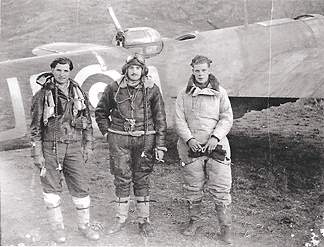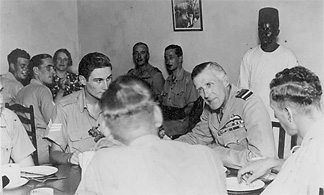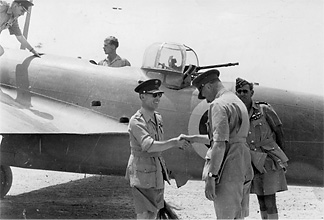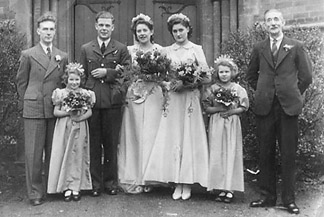 |
 |
|||||||||||||
|
909291 Sgt George F Kearns RAFVR 1918—2011 Laurie Potter, of whom more later, was born in Canada and lives in Nova Scotia. In World War II, Laurie’s father joined the West Nova Scotia Regiment of the Canadian 1st Division, serving in Italy and the United Kingdom. While stationed in England, Potter senior met the English girl who was to become his wife, Margaret Kearns. Her brother George Kearns had joined the RAFVR in September 1939—he qualified as a Wireless Operator/Air Gunner on the Bristol Blenheim. In early 1941 George was the Gunner in a crew ferrying a Blenheim IV out to Greece. There he was posted to join 211 Squadron. What follows is George’s own account, with any amplifications of mine shown in the customary way [thus]. George Kearns’ narrative December 2009
A great official shot, on the ground in Greece. The aircraft seems to be Blenheim I UQ-D (but not L8376), while the foreground and background have the look of Paramythia about them. This is a pretty relaxed shot—time for a gasper all round—and of technical interest too. The aircraft hatches are open, but the turret has been retracted and the cover fitted to the stowed Vickers K gun, while the bomb-bay is filled to capacity with four SBCs and in consequence, the doors removed. The grins hint at a return from a successful unmolested sortie, rather than the thousand-mile gazes that might be seen in a shot before take-off.] “We also ferried personnel from Paramythia to Agrinion from 12 April to 14 [April] in Blenheim L4818 [possibly L4878] after that we evacuated personnel from Greece to Crete from 21 April until 23 [April] in Blenheim L1386. When things settled down we were sent to Aquir in Palestine for operations against the Vichy French. After four operations in Blenheim N3581, V5790 and V5866 [all Mark IVs and formally of 11 Squadron] we were transferred to XI Squadron and that as far as I knew was the end of 211 Squadron. Then after the Syria campaign was over we had a short spell at Habbaniya in Iraq before going into the Desert in September 1941.”
George remarked of this occasion: “The photo was taken at Hurricane House in Cairo in July 1941. They are all 211 boys, Yours Truly in the far left corner. It was a rest house for aircrews having completed 25 operations.” Centre, left, a Sgt airman looks on intently as centre, right, Air Chief Marshall Sir EG Ludlow-Hewitt KCB DSO MC, Inspector General of the RAF, leans forward listening with great interest to another airman. Genuine concern for aircrew burned bright in Ludlow-Hewitt. He had pressed, successfully, for all aircrew to be accorded full-time professional status. His support for daylight bombing raids to have escort fighters took much longer to be achieved. Ludlow-Hewitt passed away in 1973.] P/O Hooper and crew were then posted to Strategic Reconnaissance Unit on 25 October 1941 and flew [Martin] Maryland aircraft. Hit by anti-aircraft fire, Hooper was hospitalised on 10 December 1941. Len Page, a peace-time airman, was sent to England. I flew with Sgt Welshman until 12 January 1942 when I was W/Op/AG to AVM Coningham, AOC Western Desert.”
A magnificent official shot. As a full Colonel gingerly descends the Blenheim’s wing-root foot-way, George observes uneasily from the aft hatch of an anonymous Blenheim, most likely a Mark IV. Notably, George’s turret is a rare example of the single-Browning mounting. With both feet squarely on the ground, King George (left) shakes the hand of General Ritchie, CinC 8th Army, who offers a simple neck-bow to the Greek King as AVM Arthur “Mary” Coningham DSO MC DFC AFC looks on, right, in sun glasses. An early master of tactical air power and knighted in late 1942 for his service, Coningham retired in 1947. He was lost in the disappearance of Avro Tudor IV G-AHNP Star Tiger, en route to Bermuda on 30 January 1948 over the Western Atlantic.] “I remained there until I got amoebic dysentery, was whipped down to Alexandria into 2 NZ Hospital. After a spell of sick leave I was formally posted to Air Transport Flight in East Africa and remained there until my tour of duty was over and I returned to England on 14 April 1945. Sent to RAF station Tarrant Rushton in Dorset on Airfield Control until I was demobbed on 2 December 1945.” Per ardua The period in which George served with 211 Squadron was quite difficult for a number of reasons, not least the loss of 16 men in 6 experienced crews in the desperate Easter Sunday operation against the advancing Germans on 13 April 1941. Then, on the point of departure form Greece, their secret documents were ordered to be destroyed. The formal Squadron record for the latter days in Greece is thus pretty sparse, with the Operations Record Book from March and April 1941 lost, to be re-compiled in rather less than usual detail once they were operational again in Palestine. Many of the 211s, George among them, also lost kit and mementoes in withdrawing from Greece. On moving to Aquir in Palestine after the battering by the Luftwaffe over Greece, the Squadron regrouped and resumed operations in May. Although the formal record of the time is still less complete than usual, the monthly summaries at least are once again recorded in something like customary detail.
At Aqir, the Operations Record Book for late May records one sortie over Syria against the Vichy French, identifying JCR Hooper and his crew Page and Kearns by name. And two other sorties are very likely theirs too, though only Hooper, as pilot, is named (a not unusual short-hand). Given the circumstances of the time and the state of the formal records of the Squadron, it is not surprising that these are the only Squadron Operations Record Book entries for George, his arrival apparently having gone unremarked in the press of events at Paramythia. The March/April/May 1941 period had been very difficult for the Greyhounds in every way. P/O Jeffry Campbell Ross Hooper 89777 had joined 211 Squadron with his brother, P/O John Gower Martin Hooper 89778, pilots in a draft of fresh aircrew on 23 January 1941. The pair were from Southern Rhodesia. Having joined the RAF in 1935 and 211 Squadron as groundcrew in the UK in 1937, Len Page remustered as an Air Gunner. By the time the Italians joined the war in June 1940, LAC Page was flying as an Observer, and duly accorded Sgt rank by September 1940. By mid-1941 he had completed 55 sorties with 211 Squadron over Libya, Albania and Syria and had been awarded a DFM. Hooper, Page and Kearns were then transferred to XI Squadron as a crew. After further desert operations with XI Squadron, in late 1941 they joined the Strategic Reconnaissance Unit as a crew, flying four-man Martin Marylands, Sgt Hall joining them. After a number of successful Desert sorties, Hooper was wounded by flak over Benghazi in Maryland II AH370 on 6 December 1941. Sgt Observer Len Page took control of the aircraft. Curly Kearns and Sgt Hall, offered the option of jumping for it, elected to stay aboard with their crew mates. Hooper recovered enough to land the damaged Maryland, in a sandstorm, with Page’s assistance. Hooper was awarded an immediate DFC and Page was awarded an immediate Bar to his DFM (one of only 60 awarded in World War II). Hooper, recovered, went on to complete a tour on Mosquitoes over Europe, ending the war a Flt Lt. Commissioned in 1943, Len Page completed a tour of operations over Europe as Observer with 605 Squadron on Mosquitoes, for which he was awarded a Mention in Despatches. Flight Lieutenant Leonard Robert Page DFM+Bar left the RAF in 1945. His awards are recounted by Graham Pitchfork in his wonderful Men Behind the Medals, along with a nice vignette of 211 Squadron’s Greek Tragedy. Characteristically of the old 211 Squadron aircrew, in later life George was disinclined to make too much of his four months and 11 operations with them in Greece and Palestine. Besides, his time with XI Squadron naturally had strong claim upon his affection, too. Whichever way you look at it, carrying out 48 operations in day-bombers against an aggressive enemy required determination, skill, bravery and considerable luck. We in the 21st Century are fortunate indeed to have the acquaintance of such men—those ordinary young fellows who in dangerous days stepped forward from civilian life to do very extraordinary things. Envoi
In August 2009, brother Stan from England flew to Canada to visit George and their surviving third sister, Eileen, who also lives in Nova Scotia. It was their first get together since 1964. Margaret and their elder sister Lilly had passed away earlier, but Laurie Potter, as Margaret’s youngest son, also took much pleasure in being part of the celebration. Over the course of the visit, their talk turned to the war years. It turned out that George had heard little news of his old Squadron over the years since. A little research on the internet soon put Laurie and his Uncle George in contact with me. The Kearns and Potter families are very proud of George, and of his war service. In little Flin Flon, far North in Manitoba, George took life as it came, good or bad, ever with good cheer. Undaunted by a house fire in the late Winter of 2010, he set about having his home rebuilt. Having moved back home, he later remarked to me that “worse things happen at Sea”. And so to the final journey. George fell ill in the Spring of 2011 but remained in Flin Flon, his home of 40 years. Having just reached his 93rd birthday, George departed this life peacefully on 29 August. He was laid to rest in the Ross Park Cemetery at Flin Flon on Thursday 1 September 2011. George will be much missed. It has been a pleasure and a privilege to know such a man. Sources M Barrass Air of Authority (www.rafweb.org) www.211squadron.org © D Clark & others 1998—2025 |
|||||||||||||






